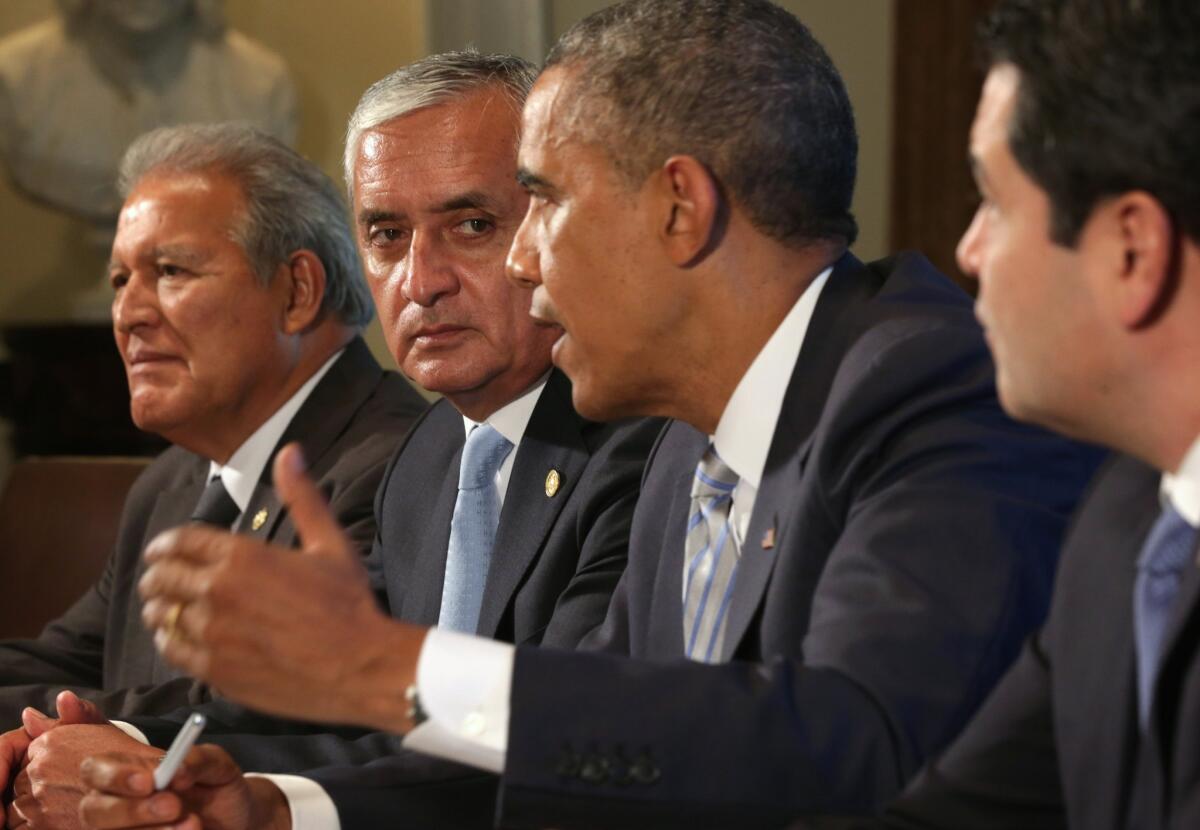Op-Ed: A U.S. immigration solution: Fix Central America

- Share via
For the citizens of El Salvador, Guatemala and Honduras, the crisis prompted by the surge of children from Latin America coming across the U.S. border is not simply an immigration story. It is about more than unemployment, poverty, gang violence and the other forces that split families and lead parents to make desperate decisions.
As people from these countries repeatedly tell me, the crisis comes down to this: What will it take for my homeland to become a place where I can safely live, work and raise my children?
Fifteen years ago, people in my native Colombia asked the same painful question. A seemingly endless cycle of violence fueled by insurgent groups and drug cartels, combined with widespread poverty, had made it difficult to believe that Colombia could ever escape its downward spiral.
But we did. Thanks in large part to Plan Colombia — a decade-long, $8-billion U.S. aid program to help rebuild institutions, eradicate drug production and expand social protection — Colombia has undergone an extraordinary turnaround. Although it still struggles with high levels of crime, violence has dropped to a fraction of what it was in the 1990s. Investment is pouring in, economic growth is strong and, most important, young people no longer see migration as the only route to a better life.
Now, the presidents of Central America’s Northern Triangle nations are calling for a comparably ambitious joint effort that would combine foreign aid and local resources to attack the root causes of the immigration crisis.
Could such a plan work? Skeptics point out that Plan Colombia, launched under President Clinton and continued by President George W. Bush, enjoyed sustained bipartisan support that would be hard to summon today. Others question the viability of working with three governments, each much smaller and poorer than Colombia was in the 1990s.
These are serious obstacles, but from my conversations with Honduran President Juan Orlando Hernandez, Guatemalan President Otto Perez Molina and Salvadoran President Salvador Sanchez Ceren, it is clear that they are determined to work together to craft a credible, accountable and achievable plan to present to potential supporters in Congress.
This plan will be credible if Central Americans believe it reflects their priorities and not an agenda imposed from abroad. Simply put, they want jobs, better education and healthcare, and law enforcement capable of ending violence and impunity.
Accountability will depend on adopting clear, verifiable goals and making commitments that extend far beyond the current administrations. Only then will foreign donors and their fellow citizens be convinced that a significant expansion in development aid can be effective.
Key stakeholders must also accept their shared responsibility. For U.S. firms that rely on undocumented migrants for cheap labor, this could mean supporting an expanded, well-regulated guest worker program. For Central American firms, it would mean shouldering a larger tax burden to finance better public services. For U.S. legislators calling for Central America to clamp down on drug trafficking and gangs, it would entail heeding Marine Gen. John Kelly, head of the U.S. Southern Command, who recently said that corruption and violence in the Northern Triangle are “directly or indirectly due to the insatiable U.S. demand for drugs.”
It could cost Washington much less to help Honduras, Guatemala and El Salvador to become more stable and prosperous than it does to deal reactively with the immigration crisis. Consider that tuition at the most expensive university in Honduras is about $6,500 a year. That is a 10th of what Washington spends to house and feed a minor held at a detention center for a year.
In its early stages, critics of Plan Colombia dismissed it as expensive and unrealistic. But they underestimated Colombians’ strong desire to build a fulfilling life in their own country. We were ready to reclaim our country. The serious U.S. aid program galvanized our determination by showing us that a great nation believed in us too.
Luis Alberto Moreno is president of the Inter-American Development Bank.
Follow the Opinion section on Twitter @latimesopinion
More to Read
Sign up for Essential California
The most important California stories and recommendations in your inbox every morning.
You may occasionally receive promotional content from the Los Angeles Times.










